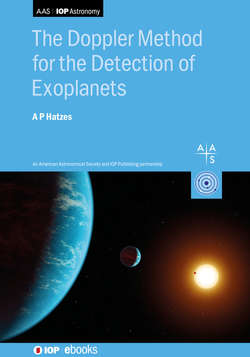Читать книгу The Doppler Method for the Detection of Exoplanets - Professor Artie Hatzes - Страница 20
На сайте Литреса книга снята с продажи.
2.1.2 Cross-dispersers
ОглавлениеThe cross-disperser element currently comes primarily in three forms: prisms, gratings, and grisms. Each provides its own wavelength dependence on the dispersive power in the cross-dispersion direction, y.
Prisms provide a separation of spectral orders that is inversely proportional to the central wavelength of the order
Δy∝λ−1(prism).(2.6)
Thus, for prism cross-dispersers, the separation between spectral orders increases as one goes to bluer wavelengths. There are two advantages to using prisms. First, they have a high throughput and tend to be more efficient than other options such as gratings. Second, they provide an efficient packing of spectral orders and thus effectively use the real estate of the CCD detector. Prisms are often the choice for echelle spectrographs built for 2–3 m class telescopes (Vogt 1987; Tull et al. 1995; Kaufer & Pasquini 1998; Vogt et al. 2014)
There are two main disadvantages to using prisms as cross-dispersers. First, the packing of orders at red wavelengths becomes too tight, making it more difficult to determine interorder scattered light (see below). Second, for large diameter telescopes prisms do not provide enough dispersive power for good order separation. One must use several prisms in a chain or, preferably, another type of cross-disperser, such as a grating.
Grating cross-dispersers provide a separation of spectral orders that is proportional to the wavelength squared:
Δy∝λ2(grating).(2.7)
In contrast to prisms, gratings have a spectral order separation that increases toward redder wavelengths. They have the advantage in that they provide a much larger separation of orders which can be set by the designer by choosing a grating with the appropriate groove spacing. This makes it much easier to remove the interorder scattered light. On the other hand, gratings have an efficiency of ≈70%, which is generally less than that for prisms. Because they are more effective dispersing devices, they are the choice of cross-disperser on echelle spectrographs built for large telescopes (Vogt et al. 1994; Dekker et al. 2000; Strassmeier et al. 2015).
Another option is a grism cross-disperser, which is a combination of prisms and gratings. This produces an order separation that should roughly be proportional to wavelength,
Δy∝λ−1(prism)×λ2(grating)∝λ(grism).(2.8)
The advantage of grisms is that they provide a more uniform spacing of orders from blue to red wavelengths. However, they tend to have even lower throughput than either prisms or grating cross-dispersers. The Tautenburg Echelle Spectrograph is one example of an echelle spectrograph that uses grisms as cross-dispersers. Figure 2.5 shows the spectral format of the various types of cross-dispersing elements.
Figure 2.5. The various types of cross-dispersers. The wavelength of the central order increases toward the bottom. (Left) A grating cross-disperser produces an order separation, Δλ, that increases rapidly toward longer wavelengths (Δλ∝λ2). (Center) A prism cross-disperser produces orders that are more tightly packed at redder wavelengths (Δλ∝λ−1). A grism produces a more uniform spacing of orders, but with a linear increase toward the red (Δλ∝λ).
